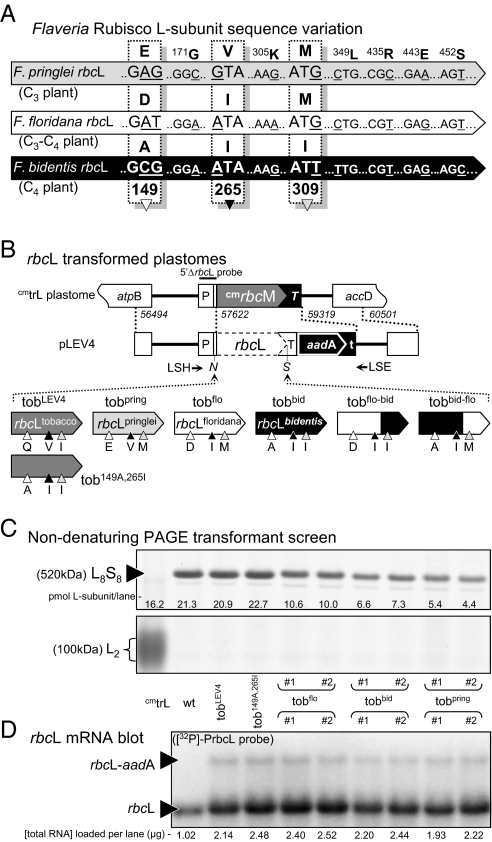Fig. 1.
Flaveria rubisco L-subunit sequence and expression in tobacco chloroplasts. (A) Comparison of Flaveria rbcL sequences that differ only in L-subunit substitutions at amino acids 149, 265, and 309 (20). (B) The transforming plasmid pLEV4 contains a homologous plastome flanking sequence (indicated by dashed lines; numbering indicates region of sequence integration relative to plastome sequence; GenBank ID Z00444) that directed integration of the rbcL transgenes and a promoterless aadA-selectable marker gene into the plastome of the tobacco master line, cmtrL (23). The L-subunit amino acid differences at residues 149 (white triangle), 265 (black triangle), and 309 (gray triangle) in the tobLEV4 (tobacco rbcL control), tobpring (F. pringlei rbcL), tobflo (F. floridana rbcL), tobbid (F. bidentis rbcL), tobflo-bid (chimeric F. floridana–F. bidentis rbcL), tobbid-flo (chimeric F. bidentis–F. floridana rbcL), and tob149A,265I (mutated tobacco rbcL) transplastomic tobacco (tob) lines are shown. Annealing locations of primers LSH, LSE, and the 5′ ΔrbcL probe (24) are shown. N, NheI; S, SalI cloning sites. (C) Nondenaturing PAGE analysis of soluble protein from comparable leaves of independent T0 transplastomic lines, cmtrL, and wild-type tobacco (protein from 1.5 mm2 of leaf was loaded per lane). Homoplasmic transformants produce only L8S8 rubisco (∼520 kDa) and not the ∼100-kDa R. rubrum L2 rubisco produced in cmtrL (23). (D) Detection of rbcL and rbcL-aadA mRNA in total RNA from 3 mm2 (for wild type) or 6 mm2 (other samples) of the leaves sampled in C.

